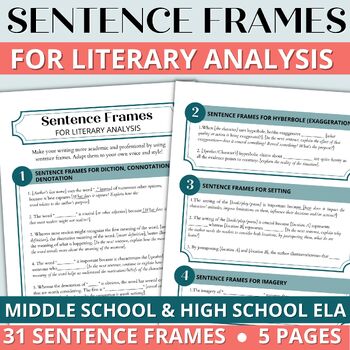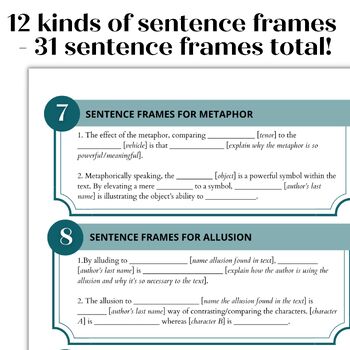Sentence Frames for Literary Analysis Essay Writing High School ELA, ELL & ESL
- PDF
What educators are saying
Also included in
- Teach your students how to write a 5 paragraph Literary Analysis Essay with this bundle! This is common-core aligned for 7th, 8th, 9th, and 10th grades and academic ESL. This no-prep tutorial will make it easy for you to teach students to write a literary analysis essay on any topic or text. This wiPrice $19.00Original Price $22.00Save $3.00
Description
Use sentence frames (also called sentence starters) for literary analysis in your ELA or ESL classroom to support all students! Research shows that sentence frames are an effective scaffolding technique. Use sentence frames for differentiated instruction and to support ELL and newcomer students. This is appropriate for 7th-12 grade.
This resource is a 5-page handout that includes 12 types of sentence frames for writing about literature: Diction/connotation/denotation, hyperbole, setting, irony, juxtaposition, symbolism, imagery, metaphor, tone, allusion, allegory, problem breakdown, and reasons for character actions. There are 31 sentence frames total.
***This is included in my Literary Analysis Essay Bundle for Middle School and High School. Save big with bundles!***
Teaching figurative language to middle schoolers or high schoolers? Grab this Figurative Language Bundle!
Need to start with paragraphs? Check out my Paragraph Bundle for Adult ESL and High School ELL.
Note: These resources have non-editable, secured PDFs. I do this to protect my work.
Copyright © English Teaching Toolkit
All rights reserved by author.
Please purchase additional licenses if you intend to share this product.
If you are having issues with a file, please go to the FAQs section, submit a help ticket, or ask a question on the Q & A tab before leaving feedback.






